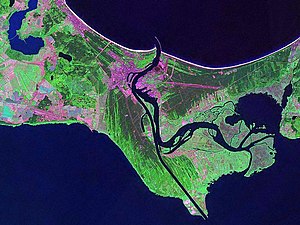Rear delta
|
|
|
|---|---|
| The Swine and its downright exemplary rear delta |
A regressive delta or reverse current delta (also decline in delta or rear Delta called) is a sedimentary body, which at the landward exit (the back) of a sea channels may form.
In contrast to a river delta , the sediment body is not created by the activity of a river, but by marine sedimentation , i.e. H. Transport and deposition are carried out by ocean currents: When storms occur, sediment-rich seawater is pushed through the sea channel into the lagoon behind . The sedimentation takes place immediately after the passage of the sea channel, because there the flow velocity drops sharply. The excess water either flows away from the lagoon via sea gates facing away from the current or, if there are none, it leaves the lagoon after the storm has subsided via the same sea gates, but at much lower flow velocities, so that the rear delta is not eroded .
Well-known back deltas on the Baltic coast are those of the Prerower Strom (in the form of the Schmidtbülten island) and the Swine . At least parts of the Große Kirr south of the village of Zingst could also be traced back to the activity of a rear delta that was located at the exit of a now closed sea channel between the western and central section of the Zingst peninsula.
To the west of the Sea of Azov forms Strait of Henichesk a regressive delta toward the Syvash -Lagune. Both in the inner and outer Chaur al-Udaid on the Persian Gulf in Qatar , rear deltas that are largely or completely underwater are currently emerging.
Individual evidence
- ↑ Geology of the Seas and Inland Waters. Volume 3, 1967 (reprint from 1939), p. 190.
- ↑ Leberecht Jeschke, Elsbeth Lange: On the genesis of the coastal flood moors in the area of the Western Pomeranian lagoon coast. Pp. 208–215 in: Konrad Billwitz, Klaus-Dieter Jäger, Wolfgang Janke (eds.): Young Quaternary Landscape Spaces - Current Research Between the Atlantic and Tienschan. Springer, Berlin 1991, ISBN 978-3-642-76746-3 , p. 211

